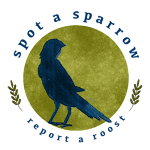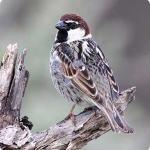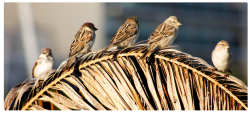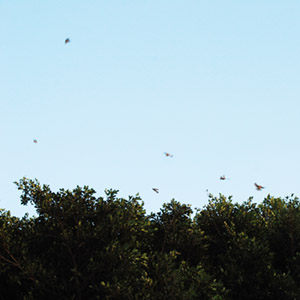Spot A Sparrow is a citizen science project that involves the Maltese community in researching one of the most common urban birds in Malta, the Spanish sparrow. To report a roost, visit the official website here.
About
The project is run by BirdLife Malta, in association with the Inspire Foundation, and aims to collect information on Spanish sparrows across the towns of Malta and Gozo.
Foundation, and aims to collect information on Spanish sparrows across the towns of Malta and Gozo.
We are especially interested in mapping sparrow roosts, where sparrows gather in autumn and winter evenings to sleep. Trees used for roosting are easy to identify, as birds get really loud right before going to sleep – and it’s important that we know where they are, so that they can be better protected.
Get Involved
So, how can you participate in Spot A Sparrow? It’s simple. Go out for a walk in your neighbourhood, or in a park, or around the coast, and keep an eye out for sparrows. Then you can go on your smartphone or your computer, head to www.spotasparrow.birdlifemalta.org, and send in your reports.
Send in the exact location of the roost you have found, and fill up the comment box with your sparrow story and any other bit of information you want to share.
Then trained surveyors from Inspire will verify the roost, and put your observation into the final reports. By the end of the project, in December 2015, we will have mapped out the most important sites for sparrows in Malta and worked together as a community to study and protect our urban nature. So, ready to start? Head over to www.spotasparrow.birdlifemalta.org now!
Spanish Sparrows
 The Spanish Sparrow (scientific name Passer hispaniolensis, Maltese name Għasfur tal-bejt, literally “house bird”) is a small bird, commonly found in the Mediterranean and in central Asia. As far as sparrows go, it is quite a large one – reaching 16 cm in length and up to 36 g in weight. The species is dimorphic, which means that male and females look different: while females are greyish brown, and rather dull to look at, males have more colorful feathers. The most striking characteristic is the reddish cap; the eyes are banded in black, with narrow white “eyebrows”; males have white cheeks, a large black “bib” on a white
The Spanish Sparrow (scientific name Passer hispaniolensis, Maltese name Għasfur tal-bejt, literally “house bird”) is a small bird, commonly found in the Mediterranean and in central Asia. As far as sparrows go, it is quite a large one – reaching 16 cm in length and up to 36 g in weight. The species is dimorphic, which means that male and females look different: while females are greyish brown, and rather dull to look at, males have more colorful feathers. The most striking characteristic is the reddish cap; the eyes are banded in black, with narrow white “eyebrows”; males have white cheeks, a large black “bib” on a white  underside, and striped black and brown back, wings and tail. Fledglings are similar to females in colour, but look chunkier and goofier. Different, abnormal colourings are however surprisingly common in Maltese sparrows! Keep an eye out for leucistic birds with white feather on their wings, tails or head, for entirely albino ones, and for melanistic, all-black sparrows.
underside, and striped black and brown back, wings and tail. Fledglings are similar to females in colour, but look chunkier and goofier. Different, abnormal colourings are however surprisingly common in Maltese sparrows! Keep an eye out for leucistic birds with white feather on their wings, tails or head, for entirely albino ones, and for melanistic, all-black sparrows.
Spanish sparrows are very vocal, and use different calls for a variety of purposes, including contact, flight, alarm and threat. Typical sparrow sounds include jig, jeuw, jeerr, greer, chilli, chirrup, and seuw, and each sound is generally repeated twice to form a call. Roosts are especially loud, with many different calls overlapping in a high-pitched, chaotic choir. Adult sparrows are mostly frugivorous, which means the largest portion of their food consists of seeds, grains and fruits. They will however eat small invertebrates, bugs like insects and spiders, as well. Nestlings are actually fed only bugs until they are a few days old. Parent sparrows progressively increase the amount of grains they feed to their children until they are ready to move on to a healthy – if boring – seed-based diet.
The species breeds in all three main islands and can be easily observed throughout the country thanks to its large numbers – up to 300000 pairs have been estimated. Spanish sparrows favour urban areas and are perfectly adapted to nesting in buildings, which is one of the reasons why they are so commonly found in cities. Sparrows start building their nest in February, in holes and cracks in walls, cliffs and caves, on window sills, trees, and any other similar site. The breeding season lasts until August and starts with fights between males, who get a bit violent in order to secure a nesting site. Fights are so intense that the boys lose track of their surroundings, and are vulnerable to predators like cats, or to being run over by cars. In cities, pairs nest on their own, and there is some distance between two or more nests. In rural areas, however, colonial nesting happens as well, and several pairs nest together in the same site. Both parents build the nests, which is bulky and messy, with hay, grass, wool, straw and similar materials.
Between three and six colourful eggs are laid. Eggs vary in colour, and can be white, bluish, grey and greenish, with darker speckles. While the female is the main incubator (she is the one who sits on the eggs for most of the time) the male also incubates the eggs when the female is feeding. Chicks hatch after 14 days, and are fed by both parents, who can lay eggs and raise chicks up to four times a year.
Sparrows used to be on Maltese menus as well! In the past, when food was scarce, Maltese men would catch sparrows with nets to eat them or sell them at the market as food. This was such a common practice that farmhouses would have holes carved in their walls, so that sparrows would be encouraged to nest and could be caught more easily. Obviously, this was not good for sparrows, and at the beginning of the 20th century they were almost gone – until they were protected by law 1916. Now no one would dream of catching sparrows for food! 
Project Partners
Inspire – The Foundation for Inclusion Inspire helps over 1000 individuals and their families reach their fullest potential, by providing educational, therapeutic and leisure service. We also advocate for inclusion, educate the general public, raise awareness among peers, and hold the best knowledge base on disability on the island.
Inspire helps over 1000 individuals and their families reach their fullest potential, by providing educational, therapeutic and leisure service. We also advocate for inclusion, educate the general public, raise awareness among peers, and hold the best knowledge base on disability on the island.
The project is funded by the EEA Grants NGO Malta Programme 2009-2014, which is administered by SOS Malta.





